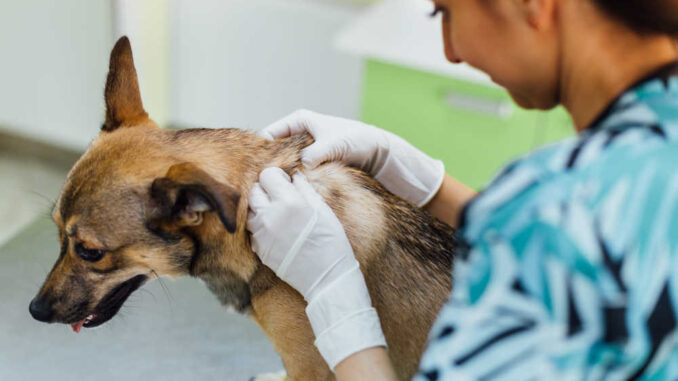
This article was updated on March 12th, 2024

The majority of black scabs will be insignificant and pose no threat to your dog. However, some black scabs could be linked to more serious underlying causes, such as allergies or parasites. As a dog owner, it’s important to know the difference. In this article, our veterinarians examine the likely reasons your dog has a black scab and give advice on when to seek veterinary care.
Key highlights:
– Black scabs can be caused by wounds, allergies, parasites, growths, and hyperpigmentation
– Wounds typically heal in a few weeks, but black scabs caused by underlying medical issues may worsen over time.
– Black or dark scabs that don’t heal or get worse should be seen by a veterinarian
– You should also see your vet if your dog shows signs of discomfort
– A gentle bath as well as cream and vaseline may help mild cases
6 things to know when you see a black scab on your dog
1. Scabs typically take 2-3 weeks to heal, unless there is an underlying medical issue
The timeline for a scab to heal partly depends on the underlying cause. If healing in a healthy manner, most scabs will start to dry up and heal over the course of a few weeks (sometimes even quicker if the scab is very small.)
However, black scabs can also be caused by underlying medical issues such as allergies. If the underlying issue is not treated or resolved, the black scabs may persist or worsen.
2. Worsening black scabs should be investigated by a veterinarian
There may be some situations where it’s fine to just monitor and leave a black scab on your dog. This isn’t always the case, however, so it’s important to know the difference:
“Black scabs that have a known cause such as a recent wound may be okay to monitor. Often these will resolve on their own. On the other hand, black scabs that have been present for a while or that are getting worse should be investigated. You should call your vet if your dog shows any signs of discomfort or illness, such as itching or red skin.”
This is especially true if the black scabs are associated with a lump or raised area, as this could indicate a malignant tumor. Black raised lumps should be investigated sooner rather than later for fear that they could be something sinister.
3. You should also see your vet if your dog is itching or showing signs of discomfort
If your dog is really bothered by the scab and keeps scratching at it then they will likely need treatment to help resolve the underlying condition and speed up the healing process.
If your dog is displaying any other symptoms of being unwell, such as vomiting, diarrhea, or general lethargy, then they should also be seen by your veterinarian.
4. Common causes of black scabs on a dog’s skin
Here is a list of the most common causes of black scabs in dogs:
1. Wounds
One of the most common reasons I see for black scabs is simply that the dog got injured. As time goes by and the wound heals, the clot dries out and forms a scab. This provides a protective layer over the vulnerable wound while it heals. The scab will often darken as it gets older, and the blood dries up, sometimes to the point where it appears black. View an example picture of a wound with black scabs.
Most wounds will heal on their own if not aggravated. On the other hand, if your dog tends to lick at wounds, then they might benefit from an Elizabethan collar. Larger wounds may require stitches or staples, so be sure to seek veterinary advice if this is the case.
2. Allergies
Up to 1 in 5 dogs suffer from allergies: dogs can be allergic to pollen, dust mites, certain foods (including proteins), or insect or flea bites. An allergic reaction to something in your dog’s environment or their food results in inflammation of their skin. This appears as redness, a rash, or hives on the surface of your dog’s skin and can be very irritating for them.
While an acute allergic reaction may cause redness of the skin, more chronic allergies can result in a darkening of the skin, sometimes to the point where the skin appears black. This is because, over a longer period of time, inflamed skin can become hyperpigmented. As this skin sheds, it can appear as black scabs, as shown in the picture below:
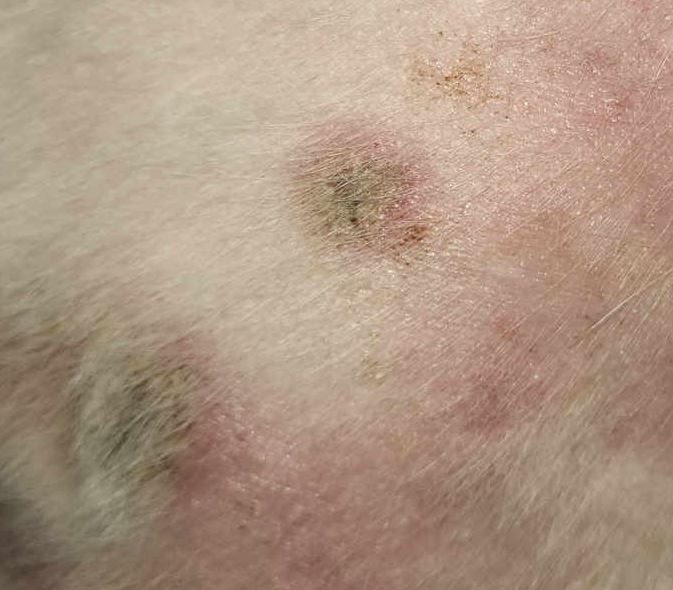
Owners can also recognize allergies in their dogs with signs like itching, skin rashes, sneezing, watery eyes, ear problems, or digestive issues like vomiting or diarrhea.
If your dog has been suffering from allergies for a prolonged period of time, then it may be best to get your veterinarian involved. Acute allergic reactions often require steroids or other anti-allergy medication. Food allergy trials or blood tests may also be needed to identify the underlying allergen. Learn more about skin issues due to allergies.
3. Parasites (or itching excessively due to parasites)
Parasites, like fleas or mites, living on your dog’s skin can cause black scabs to appear. Fleas don’t spend long on your dog—they bite and jump off—but they do leave behind feces (“flea dirt”). Flea feces look like small bits of black dirt on your dog’s fur, as shown in the picture below:
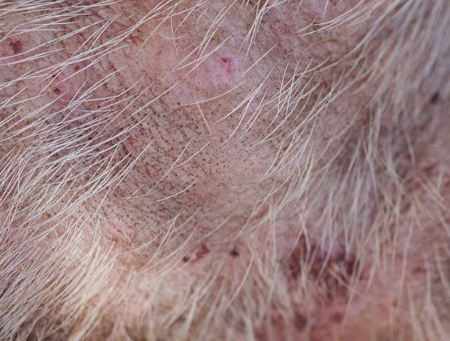
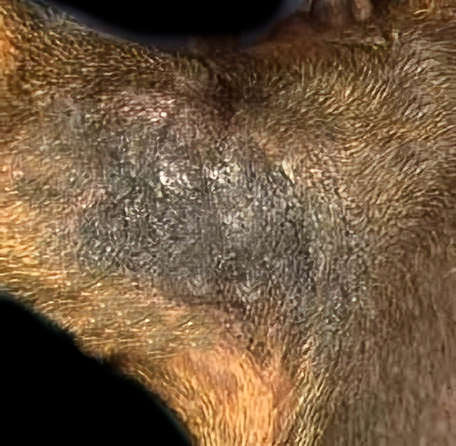
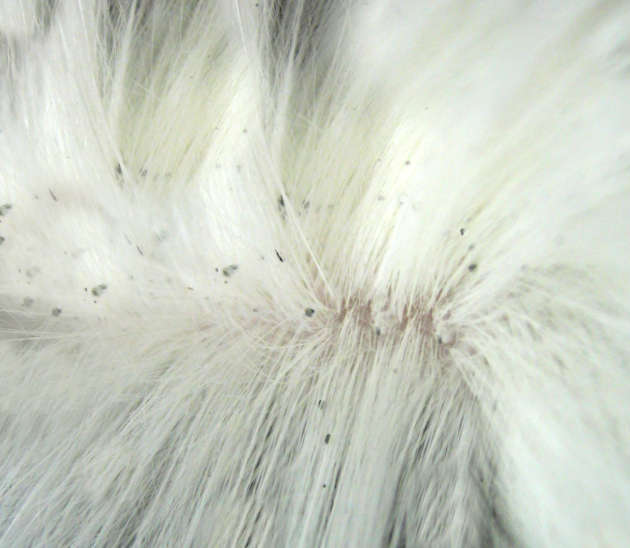
Mites also affect your dog’s skin by burying under the surface of the skin or affecting the hair follicles. This results in inflammation and extreme irritation. Dogs with a mite infestation will often frantically itch at themselves to the point of causing self-trauma. The wounds that your dog causes while doing this will form into scabs, which often become darker in color as time goes on.
It’s very important to keep your dog’s anti-parasite medication up to date to prevent such parasites from taking up residence on your dog. If you think that your dog may have an active parasite infestation, then seek veterinary advice. Learn more about flea scabs or skin issues due to mites.
4. Growths
Some growths on your dog’s skin can appear like black scabs. Lumps, warts, and masses can grow anywhere on your dog’s body. Sometimes these will contain hyperpigmented tissue, giving them the appearance of a black scab, as shown in the picture below:
It’s also possible that your dog is itching at a mass and causing trauma, which then forms into a black scab as it heals. While many skin growths are benign, not all of them are. A certain type of skin mass called melanoma, which contains a lot of the black pigment melanin, often appears very black by definition. These are malignant, or cancerous, lesions of the skin and should be investigated by your veterinarian immediately. View more pictures of melanomas.
Moreover, any masses on your dog’s body that are growing rapidly, changing shape or texture, or that appear very black should be checked out by your vet.
5. Hyperpigmentation
Another reason for what looks like black scabs on your dog’s skin is simply hyperpigmentation (Black spots on dog skin). Pigment is naturally found within your dog’s skin to differing degrees and in different parts of their body. Sometimes an area can become very dense in pigment, or hyperpigmented, and this can appear as black scabs.
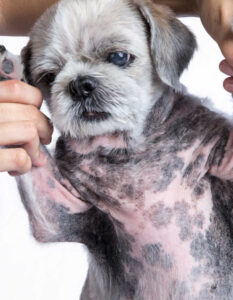
Hyperpigmentation has many causes. These include genetics, hormonal imbalances, allergies, and skin infections. For the most part, it isn’t too much of a worry, as long as your dog isn’t showing any other symptoms of being unwell. If you’re at all concerned, have your vet check it out.
5. For mild cases, consider gently bathing the area and as well as applying Vitamin E and Vaseline
“Scabs are the body’s natural way of healing, so the less interference, the better. For dogs prone to licking or chewing at wounds, an Elizabethan collar can help to move the process along safely.”
There are also a few steps owners can take at home to ensure black scabs heal faster:
- Gently bathe the scab with warm water. Don’t rub the scab too hard, as you don’t want it to peel off. Avoid any harsh chemical soaps since they can delay the healing process.
- Apply cream to the scabbed area. A vitamin E cream such as this will provide vital nutrients that allow the skin to heal.
- Once the cream has soaked in, apply Vaseline to the area. This will provide a protective barrier over the affected area, preventing bacteria from getting in and keeping the area moisturized.
It’s important to remember that the above steps are no substitute for veterinary care. If your dog’s black scabs aren’t healing, or if your dog shows signs of illness or discomfort, see the vet immediately.
6. Your vet may need diagnostic tests, such as skin scrapes, to diagnose the issue
In order to reach an accurate diagnosis, there are various tests that your vet might want to perform.
The first thing they’ll need is an accurate history of exactly what the issue is, when it started, and how long it’s been going on. Therefore, it’s important to have an idea in your head of the answers to these questions (see the next section).
Your vet will also perform a clinical examination of your dog, focusing on the skin lesions in question. At this point, they might choose to take samples for testing or a trial treatment if the likely cause is obvious.
Samples of your dog’s skin include skin scrapes, hair plucks, and impression smears—these are all examined under the microscope for clues as to what might be causing the black scabs. Your vet may also want to perform blood tests to look for signs of systemic illness.
Be prepared for these questions before your vet visit:
“Prior to visiting your veterinarian, it’s a good idea to have answers prepared to questions that they might ask you. This will not only save you time and money but will allow for faster diagnosis and treatment of the condition affecting your dog.”
Questions your vet might ask include:
- When did you first notice black scabs on your dog?
- Are the black scabs getting worse or better?
- Is there any obvious cause of the black scabs, such as a wound or injury?
- Is your dog scratching or bothered by the black scabs?
- Is your dog otherwise well in themself? Any other symptoms?
- Have you tried any remedies at home for your dog’s black scabs?
Scabs turn black when excess melanin accumulates in the skin
Black scabs are similar to other scabs in that they are dry, crusty lesions that often develop following a wound or inflammatory process in your dog’s skin. However, the difference is that black scabs are also hyperpigmented—giving them a darker appearance.
“While this darker appearance can just indicate that the scab is older, hyperpigmentation usually occurs when excess melanin accumulates in the skin, resulting in the darkening of the skin’s surface. This process can occur spontaneously or following inflammation of the affected area.”
Related Post: Black spots on dog skin
Related posts about scabs in dogs:
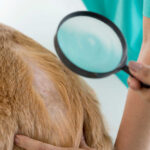 Scabs on Dogs [With Pictures]: Our Vets Explain What To Do - One common problem we often encounter as veterinarians is the presence of scabs (serous crusts) on a dog’s skin. Scabs… [...]
Scabs on Dogs [With Pictures]: Our Vets Explain What To Do - One common problem we often encounter as veterinarians is the presence of scabs (serous crusts) on a dog’s skin. Scabs… [...]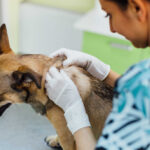 Crusty Scabs on Dogs: Top Causes and What To Do [Vet Advice] - Scabs serve as protective shields for injured skin, forming when skin is compromised, akin to a band-aid's role in human… [...]
Crusty Scabs on Dogs: Top Causes and What To Do [Vet Advice] - Scabs serve as protective shields for injured skin, forming when skin is compromised, akin to a band-aid's role in human… [...] Dog with Scabs & Losing Hair: Our Vet Explains What to Do - A dog losing hair in patches with scabs is a problem that many owners come to see us about at… [...]
Dog with Scabs & Losing Hair: Our Vet Explains What to Do - A dog losing hair in patches with scabs is a problem that many owners come to see us about at… [...]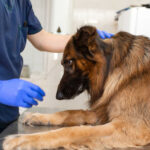 Scabs on Dog’s Head or Neck: Top Reasons [With Pictures] - Discovering scabs on your dog's body can be alarming, particularly when these scabs are on your dog's neck or head.… [...]
Scabs on Dog’s Head or Neck: Top Reasons [With Pictures] - Discovering scabs on your dog's body can be alarming, particularly when these scabs are on your dog's neck or head.… [...] Dog Nose Scabs and Lumps [Pictures & Vet Advice] - Dogs use their nose and sense of smell to explore the world around them. As most owners know, dogs will… [...]
Dog Nose Scabs and Lumps [Pictures & Vet Advice] - Dogs use their nose and sense of smell to explore the world around them. As most owners know, dogs will… [...]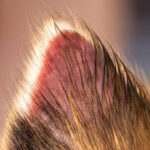 Dog Has Scabs On Ears: Top Causes & Vet Advice - In this article, our experienced veterinarian Dr. Chyrle Bonk walks you through common causes of scabs on a dog’s ears,… [...]
Dog Has Scabs On Ears: Top Causes & Vet Advice - In this article, our experienced veterinarian Dr. Chyrle Bonk walks you through common causes of scabs on a dog’s ears,… [...]Disclaimer: This website's content is not a substitute for veterinary care. Always consult with your veterinarian for healthcare decisions. Read More.



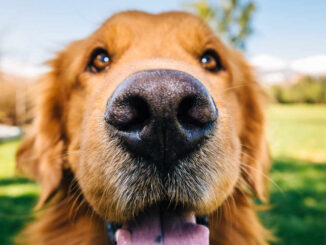
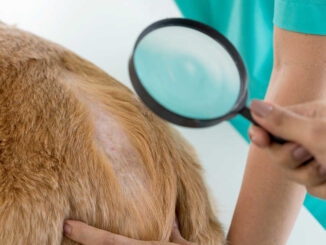

Be the first to comment